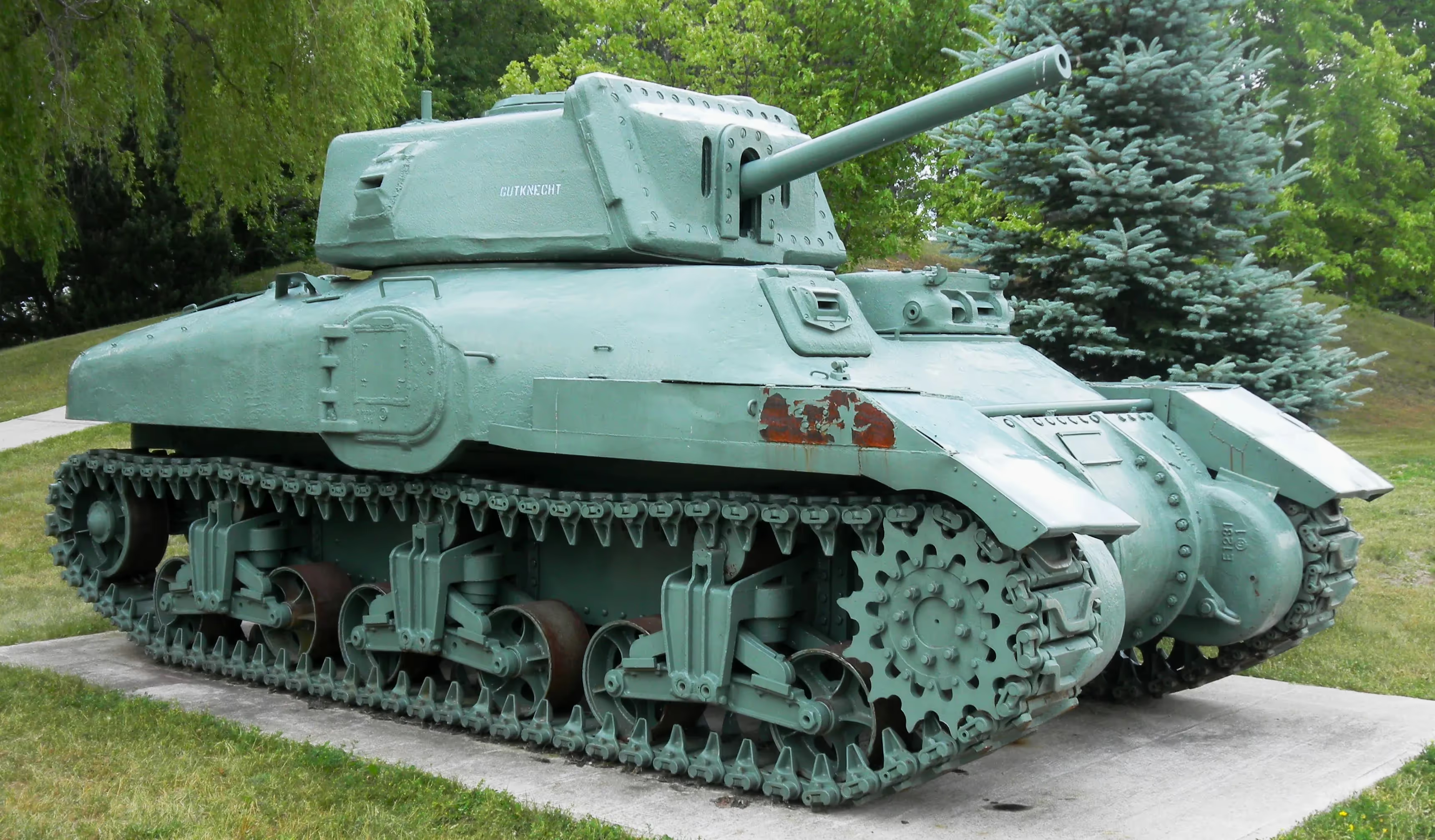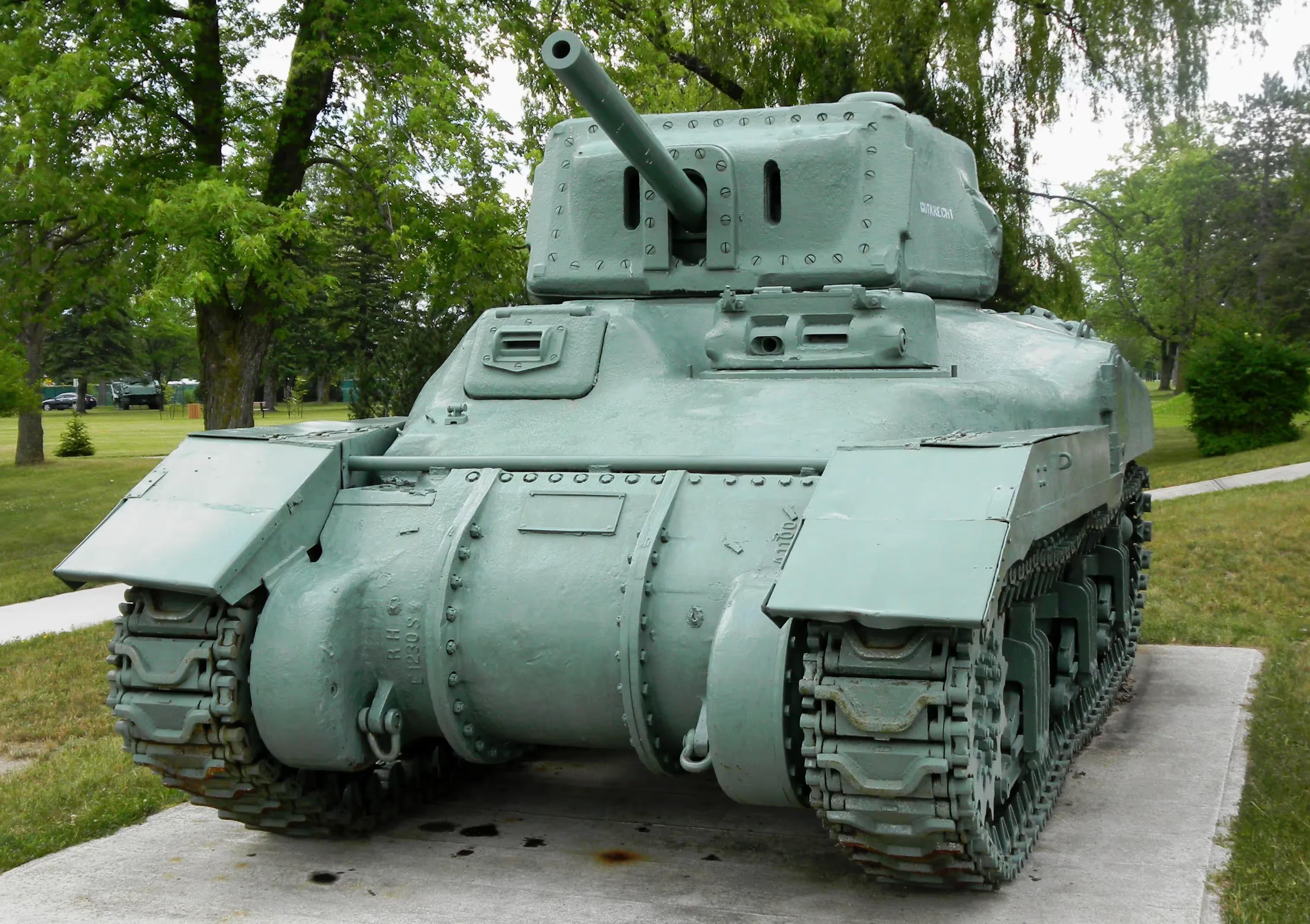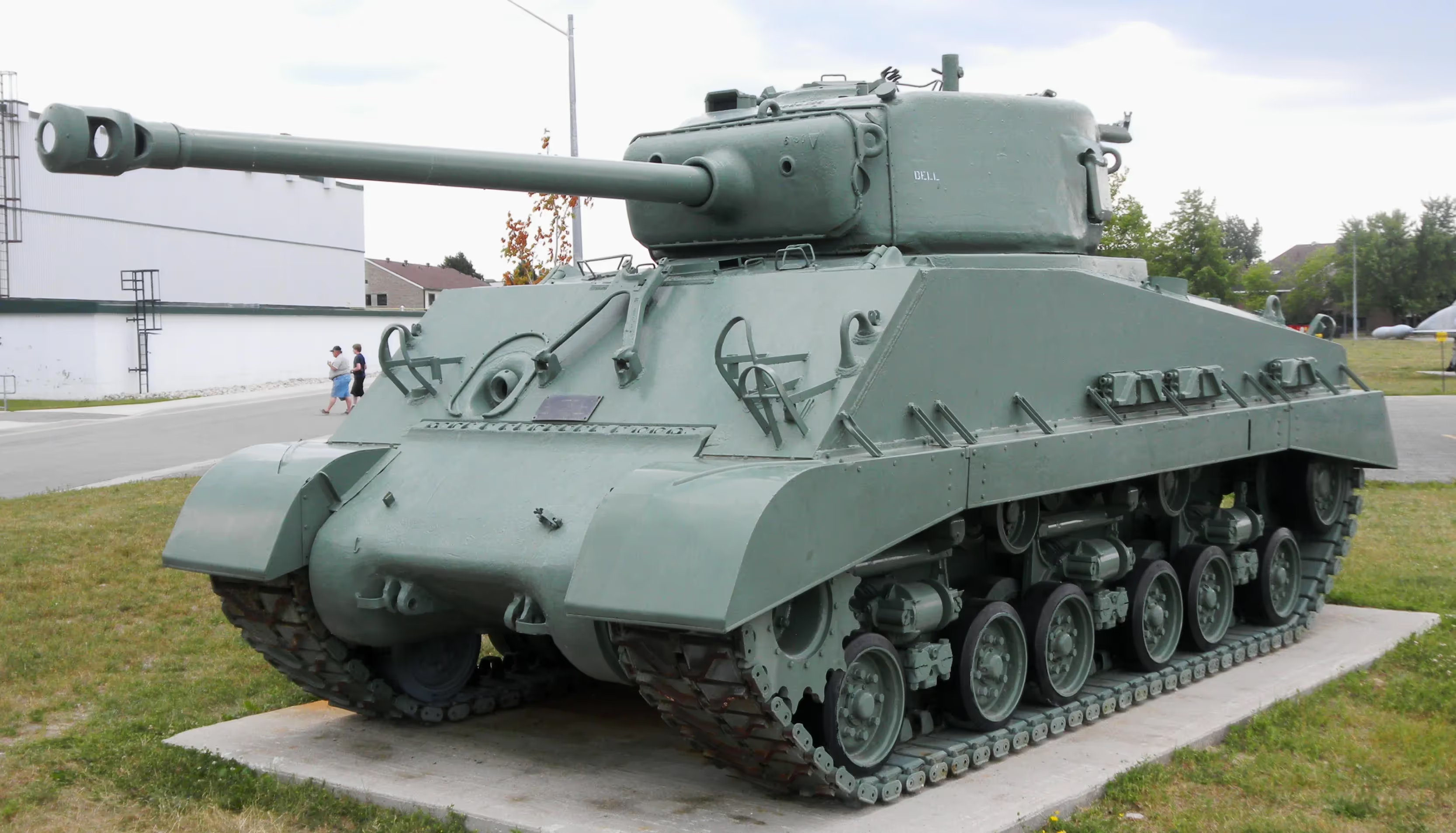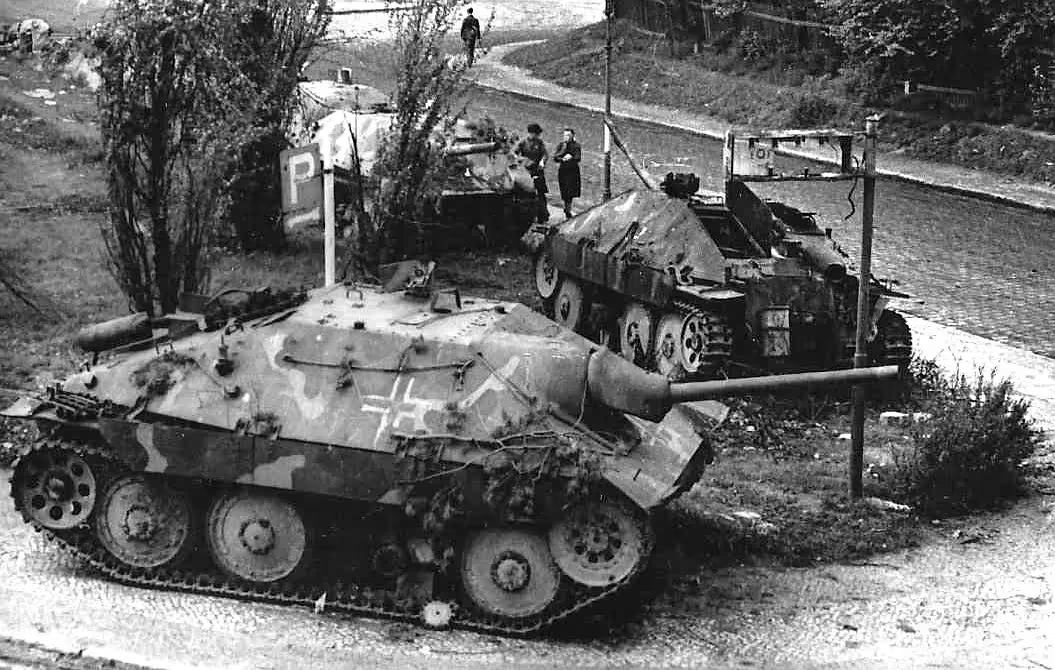Armour in Canada (5), Ontario: CFB Borden Military Museum
Tanks and Armoured Fighting Vehicles preserved at the CFB Borden Military Museum
The data and photos found on this page has been compiled by the author, unless otherwise credited. Any additions, corrections or amendments to the lists of Armoured Fighting Vehicles in Canada found on these pages would be most welcome and may be e-mailed to the author at [email protected].

The Base Borden Military Museum is a military museum located on the grounds of CFB Borden, in Borden, Ontario, Canada. Combining four separate museums, it has numerous items, equipment and vehicles from all eras of Canadian military history, including a large number of historic armored vehicles and aircraft displayed outside in the Major-General F. F. Worthington Memorial Park and around the base. The museum is located just south of Angus, Ontario. The museum, which combines all the separate museums at the base, was established in the 1990s.In June 2007 a new main building for the museum complex was opened, with a large hangar for the display of historic military vehicles. The museum complex consists of several buildings and a memorial park.The Museum is affiliated with: CMA, CHIN, OMMC and Virtual Museum of Canada. (BBMM)

(Balcer Photo)


(JustSomePics Photos)
Whippet Medium Tank Mk A tank, (Serial No. A371), “Judith”, Museum Hangar.

British Whippet Mk. A tanks advancing near Achiet-le-Petit, France, 22 Aug 1918. (National Library NZ Photo)

British Whippet tank, Aug 1918. (Henry Armytage Sanders, IWM Photo)

Canadian Brigadier General (V.W. Odlum), with Renault reconnaissance tank, France, ca 1918. (University of Victoria Library Photo)

(Balcer Photo)
M1917 Light Tank, Museum Hangar.

M1917 tanks arrive at Camp Borden, Oct 1940. (Library and Archives Canada Photo, MIKAN No. 3325255)

M1917 tanks arrive at Camp Borden, Oct 1940. (Library and Archives Canada Photo, MIKAN No. 3563837)



(JustSomePics Photos)
Vickers Mk VIb Light Tank, Museum Hangar.

(Library and Archives Canada Photo, MIKAN No. 3608073)
Vickers Light Tank AA Mk 1, being examined by Canadians.

(IWM Photo, E 16827)
Vickers Light Tank AA Mk 1, a stop-gap anti-aircraft tank armed with four 7.92-mm machine guns, 15 September 1942.

Canadian Matilda Mk. II tank troop, training in the UK, ca 1942. (Library and Archives Canada Photo, MIKAN No. 3607967)

Canadian Matilda Mk. II tank, possibly Gen Crerar in the UK, ca 1942. ((Library and Archives Canada Photo, MIKAN No. 3613152)


(JustSomePics Photos)
Matilda Infantry Tank Mk. II, Museum Hangar.

Valentine Infantry Tank Mk. III, under construction in Montreal, 23 May 1941. (Library and Archives Canada Photo, MIKAN No. 31925884)
The Valentine Infantry Tank Mk. III built by the CPR Angus Shops in Montreal, Quebec, was designed for the support of infantry in attack. It entered production in England in 1940 and in Canada in 1941. The first examples of this tank with a three-man turret went to the Canadian Armoured Fighting Vehicles Training Centre at Camp Borden where they were used for gunnery and tank commander training. 1,390 Canadian produced Valentines were sent to Russia, while 30 remained in Canada for trials and training. Valentines were powered by a General Motors 6-cylinder, 2-cycle Diesel Engine and equipped with three-wheel Bogie assemblies. Its main armament was an Ordnance QF 2-pounder Mk. IX gun and a .30-calibre Brownning M1919A4 machine-gun co-axially mounted on the mantlet. War department numbers for the 30 Valentines in Canada ran from CT-138916 to CT-148945.

(Balcer Photo)


(JustSomePics Photos)
Valentine Infantry Tank Mk. III. Museum Hangar.

Valentine Bridgelayer tank, near Melfa, Italy, 23 May 1944. (Library and Archives Canada Photo, MIKAN No. 3586332)

(Library and Archives Canada Photo, MIKAN No. 3191555)
Sherman V and Stuart tanks, a RAM tank OP and a M7 Priest Kangaroo with tarp, 4th Canadian (Armoured) Division - 29th Armoured Reconnaissance Regiment (The South Alberta Regiment), in village square, Bergen-op-Zoom, Netherlands, 31 Oct 1944.

(Author Photo)
M5A1 Stuart Light Tank, (Serial No. 3894), MGen Worthington Memorial Park, No. 1 beside the memorial marker.

(Author Photo)
M5A1 Stuart Light Tank, (Serial No. 5193), MGen Worthington Memorial Park, No. 2 beside the memorial marker.

Churchill tank of the Three Rivers Regiment taking part in Exercise SPARTAN, England, 8 March 1943. (Library and Archives Canada Photo, MIKAN No. 3209253)

Churchill tank, on maneuvers with a Canadian unit in England, ca 1942. (Library and Archives Canada Photo, MIKAN No. 3607575)

(Library and Archives Canada Photo, MIKAN No. 3608069)
Churchill tank, on maneuvers with a Canadian unit in England, 1942.

(Library and Archives Canada Photo, MIKAN No. 3613172)
Churchill tank, on maneuvers with a Canadian unit in England, 1942.

(Library and Archives Canada Photo, MIKAN No. 3613173)
Churchill tank, on maneuvers with a Canadian unit in England, ca 1942.

Churchill tank with a Canadian unit in England, disembarking from a Landing Ship Tank (LST) ca 1942. (Library and Archives Canada Photo, MIKAN No. 3607965)



(Author Photos)
Churchill Infantry Tank Mk 1, (Serial No. T31108), "MacDonald", MGen Worthington Memorial Park. This tank was used for cold weather testing at Kapuskasing, Ontario from 2 March to 2 April 1942.

(Library and Archives Canada Photo, MIKAN No. 3223876)
Churchill Infantry Tank Mk 1, 12th Canadian Army Tank Regiment (Three Rivers) taking part in Exercise Spartan in the UK, 8-10 March 1943.

Ram II tank with 6-pounder gun, A33 Canadian Armoured Corps Training Establishment, Camp Borden, Ontario, 7 July 1943. (Lt Ken Bell Photo, Library and Archives Canada Photo, MIKAN No. 3587207)

Ram II tanks in service at Camp Borden, ca. 1943. (Library and Archives Canada Photo, MIKAN No. 4232758)

Ram II tanks in service with the 27th Armoured Regiment (the Sherbrooke Fusiliers Regiment) of the 2nd Armoured Brigade and the North Nova Scotia Highlanders of the 9th Infantry Brigade on manoeuvres, conditioning for Second Front Operations, 13 April 1944. (Library and Archives Canada Photo, MIKAN No. 3255723)



(Author Photos)
Ram II tank with auxiliary turret, Shop No. 167, (Serial No. WD CT39947), MGen Worthington Memorial Park.

Ram II Tank, Camp Borden, ca 1943. (Library and Archives Canada Photo, MIKAN No. 4232753)

Ram II Tanks, Camp Borden, ca 1943. (Library and Archives Canada Photo, MIKAN No. 4232618)

(Balcer Photo)


(JustSomePics Photos)
Ram II tank with auxiliary turret removed (Serial No. 1399), TKC, (Serial No. WD CT159854), Museum Hangar.


(Author Photo)
Grizzly tank (75-mm gun), Shop No. 13, North Gate, CFB Borden Military Museum, Ontario.


(Author Photos)
Grizzly tank (75-mm gun), Shop No. 98, MGen Worthington Memorial Park.




(Doug Knight Photos)
Grizzly tank with 17-pounder Firefly turret, (Serial No. 65), one of a kind prototype, Museum Hangar.



(Author Photos)
M4A2(76)W HVSS Sherman "Easy 8" tank (Serial No. 64985), built by Fisher, Reg. No. 30122964, full side skirts, MGen Worthington Memorial Park.

(Library and Archives Canada Photo, MIKAN No. 4542721)
Tank crew of the Sherbrooke Fusiliers, 27 Canadian Armoured Brigade, changing the tracks on a Sherman III tank in England, 20 April 1944. The soldier in front of the tank has directed the driver to reverse the drive sprockets to pull the T49 steel tracks to the rear while the soldier at the side of the tank is guiding the tracks over the steel suspension units.



(Author Photos)
Sherman IIIAY tank, No. 8, (Shop No. 217), 75-mm gun, fitted with “Canadian Indestructible Roller Device” landmine exploder (CIRD) fittings, Waterloo Officer’s Mess, CFB Borden Military Museum, Ontario. Diesel variant.

(DND Photo)
Ontario Regiment crew in their M4A4 (Sherman V) during the Sicilian Campaign. The Sherman tank is the most iconic vehicle used by the Ontario Regiment during the Second World War. It was used throughout the battles in Sicily, Italy and Northwest Europe.
The first Shermans were taken on regimental charge in late April, 1943 and more tanks arrived in early May. This presented a unique situation in that the Regiment had three different tanks for a few days in early May. There were the “B” Squadron Churchills at the School of Infantry noted above, the Rams on the range at Minehead and the first few Shermans.
The crews were given conversion training on their new tank and went to the gunnery ranges at Kirkcudbright, Scotland to practice firing the main gun. As each squadron completed its firing, the tanks were painted tan and then water-proofed in preparation for the coming sea journey and seaborne landing.
By far, the most common model used by the Ontarios was the M4A4 Sherman (Sherman V in British nomenclature). It was armed with a 75mm main gun and a co-axial Browning .30 calibre machine gun. There was another Browning MG in the front of the hull, operated by the co-driver / bow gunner. The Sherman had a five-man crew: commander, gunner, loader, driver and co-driver.
A February 1945 document indicated that each of the three fighting squadrons had 16 Shermans and Regimental Headquarters had three.
The Ontarios used other Sherman models as well. In early December 1944 the Regiment received four Sherman Firefly tanks. This version used the same Sherman hull and turret (with some modifications) but mounted the more powerful, long-barreled 17-pounder main gun. It was too late to see action in Italy as the war was on pause due to winter. Gunnery training took place with these tanks. Twenty more Fireflies were issued to the Ontarios in March 1945 after the Regiment arrived in Belgium. They were assigned two per troop and put to good use in the final days of the war during the liberation of the Netherlands.
A rarer version of the Sherman used by the Ontarios was the Sherman IB, armed with a 105mm howitzer. Six were issued to the Regiment in mid-December 1944. There is very little mention in the war diary about how they were employed, other than for conversion training. They were returned to the 25th Armoured Delivery Regiment at the end of January 1945.
There were two Sherman V Armoured Recovery Vehicles held by the Light Aid Detachment. As the name suggests, this was a special version of the Sherman tank, built on the same chassis as the gun tanks, but used to recover damaged armoured vehicles. The American designation for this vehicle was M32B4.
A September 1945 report indicated that 253 Sherman tanks had gone through the Regiment since 16 August 1943. Of these, 44 were battle casualties, 14 had brewed up (destroyed by fire), one had been captured and 63 were turned in at the end of the war. The remaining 131 were listed as “uncertain”, which probably means that they were rotated out due to mechanical issues and replaced with a different tank.
With the end of the war in May 1945 the Regiment had no need for tanks. They were cleaned up, painted and turned over to Ordnance on 18 June 1945. (OntR Tanks of the Second World War)

(Library and Archives Canada Photo, MIKAN No. 3614385)
Sherman Crab flail tank coming ashore from an Landing Craft Tank (LCT), Walcheren Island, the Netherlands, fall 1944.





(Author Photos)
M4A4(75) Sherman Crab Mk. II mine flail tank with 75mm gun, built by Chrysler (Serial No. 5072) Reg. No. 3056882, DV. MGen Worthington Memorial Park.

(IWM Photo, H38080)
M4A4(75) Sherman Crab flail tank test, 27 Apr 1944.


(Author Photos)
Centurion Main Battle Tank Mk 5, 20-pounder main gun, MGen Worthington Memorial Park,
The Canadian Army took delivery of 274 Centurion Mk. 3 tanks between 1952 and 1953. The Centurion had well-sloped armour, superior mobility andexcellent gun and fire control systems compared with its then existing contemporaries. The first 21 Centurions were delivered to the Royal Canadian Dragoons in Germany in March 1952, where they served with the Canadian contingent of the NATO forces based there. The Centurions were used for training in Canada in the late 1960s and early 1970s. The Mk. 3 tanks were modified to Mk. 5 standard with the replacement of the co-axial Besa MG with a .30-calibre Browning MG. Most of the Centurions in Canada retained 20-pounder main guns, while the Centurions in Europe were upgunned to the Mk. 6 standard with the L7 105-mm main gun and additional armour in 1962. The Centurions in service with 4 Canadian Mechanized Brigade Group (4 CMBG) in Germany were brought up to Mk. 11 standard in 1965 by fitting a .50-calibre Browning HMG aligned alongside the .30-calibre Browning MG, the fitting of a 100-gallon fuel tank on the rear hull plance, and the installation of infrared night-fighting gear. Nine Centurion Armoured Recovery Vehicles (ARV) were purchased by Canada in 1954, and four armoured bridge-layers (ABL) in 1966. Centurions ended their service in Germany on 2 June 1977, and in Canada as late as 1979 when Leopard tanks began to replace them.

(Library and Archives Canada Photo, MIKAN No. 4235750)
Centurion tanks on exercise in Germany, 1964.

(Author Photo)
Centurion Main Battle Tank Mk. 5, 20-pounder main gun, in front of the Museum Hangar, Ontario.

(Library and Archives Canada Photo, MIKAN No. 4816325)
Centurion Armoured Recovery Vehicle (ARV), Ex Reforger Oct 1974, Germany.


(Author Photo)
Centurion ARV Mk. 2, MGen Worthington Memorial Park.

(Library and Archives Canada Photo, MIKAN No. 4728086)
Leopard tank, Fall Ex, Sep 1977. This is a German Leopard 1A2, which Germany loaned to Canada in 1977 to use until the C1s were delivered in 1978.


(Author Photos)
German Leopard 1A4 Main Battle Tank, "Milner", MGen Worthington Memorial Park.

(Balcer Photo)
T17E1 Staghound Armoured Car, Base HQ, CFB Borden Military Museum, Ontario.

(Library and Archives Canada Photo, MIKAN No. 4816324)
155-mm M109 SP Howitzer, 1 RCHA Ex Reforger 74, Germany. This is an orginal M109 with a short gun and retracting panoramic sight.
M109 155-mm SP Howitzer, Rod & Gun Club, CFB Borden Military Museum, Ontario.

(Library and Archives Canada Photo, MIKAN No. 3405800)
German Panzer Mk. IV knocked out near Pontecorvo, Italy, being examined by RCA soldiers, 5th Canadian Armoured Division, 26 May 1944.

(Library and Archives Canada Photo, MIKAN No. 3226723)
Canadian soldiers examining a disabled Panzer Mk. IV, Gruchy, France, 9 Jul 1944.

(U.S. Army Photo)
Captured German Second World War quadruple AA FlakPanzer IV Wirbelwinds being examined by US troops, Belgium, 30 Jan 1945.

(U.S. Army Photo)
Captured German Second World War quadruple AA FlakPanzer IV Wirbelwinds being examined by US troops, France, Sep 1944.

(world war photos)
German Second World War quadruple AA FlakPanzer IV Wirbelwind.



(Author Photos)
German Flakpanzer IV Wirbelwind, MGen Worthington Memorial Park. The Panzer IV's turret was removed and replaced with an open-top, nine-sided turret that housed a 2 cm Flakvierling 38, a quadruple mount of 20 mm cannon. A closed-top design would have been preferable, but this was not possible due to the heavy smoke generated by the four anti-aircraft guns. The combination of armor and rapid fire from the four guns of the Wirbelwind made it very effective against lightly armoured ground targets, such as trucks and armored cars; infantry were particularly vulnerable. Between 87 and 105 Wirbelwinds were converted from repaired Panzer IV chassis. (Wikipedia)

(Canadian Forces Photo, CB10-2016-0488-%20002)

(Canadian Forces Photos, CB10-2016-0488-%20003)
CF Leopard 2ER Buffalo, lifting the German Flakpanzer IV Wirbelwind. It has been moved to an indoor hangar for restoration. The Wirbelwind at CFB Borden is currently undergoing a full running and firing restoration by the Borden military museum by military and volunteers.

(U.S. Army Photo)
German Jagdpanzer 38(t) Hetzer Light Tank Destroyer, 1945.

(Wehrmacht Photo)
German Jagdpanzer 38(t) Hetzer Light Tank Destroyers, 1945.



(Author Photos)
German Jagdpanzer 38(t) Hetzer Light Tank Destroyer, MGen Worthington Memorial Park.
The Jagdpanzer 38 (Sd.Kfz. 138/2), originally the leichter Panzerjäger 38(t), known mostly post-war as Hetzer, was a German light tank destroyer of the Second World War based on a modified Czechoslovakian Panzer 38(t) chassis.
German armored forces in World War II created a variety of vehicles by mounting anti-tank guns on the chassis of obsolete tanks. These machines performed even better than expected, yet were still vulnerable due to high vehicle profiles and open-topped turrets. Allied bombings took a heavy toll on German production facilities, and further increased the need for an easily produced yet effective light tank destroyer to replace vehicles like the StuG III and Marder series. Prototypes of the Jagdpanzer 38 were ready by 1944 and mass production began in April of that year. The Jagdpanzer 38 was covered entirely with sloped armor, and possessed a compact form and low silhouette, giving it much improved defensive ability over other self-propelled guns. Armament consisted of a 7.5 cm Pak 39 L/48 gun and a remote-controlled MG 34. It featured a wide body to accommodate the four-man crew, as well as strengthened lower hull with enlarged wheels, guide rollers and tracks.
Jagdpanzer 38s first entered service in July 1944, and would eventually be assigned to a number of units, including infantry, Panzerjäger and Volksgrenadier divisions. BMM and Škoda continually modified and improved the Jagdpanzer 38 during production of the more than 2,800 vehicles built. Owing to the ease of production and high operating rates, the Jagdpanzer 38 came to serve as Germany's main tank destroyer in the latter period of the war, making an important contribution on both the Eastern and Western Fronts.

(Library and Archives Canada Photo, MIKAN No. 3230904)
Canadian soldiers with German halftrack, Norderney, Germany, 8 May 1945.

(Royal Italian Army Photo)
Italian Fiat-Ansaldo M13/40 Light Tank, Italian XX Armoured Corps, ca 1942.



(JustSomePics Photos)
Italian Fiat-Ansaldo M13/40 Light Tank, Museum Hangar.



(Author Photos)
M24 Chaffee Light Tank, MGen Worthington Memorial Park.

(Library and Archives Canada Photo, MIKAN No. 4822597)
West German Bundesrwehr M48A2GA2 that has been upgunned with the 105-mm gun used in the Leopard 1. Exercise Certain Rampart 80, Germany, Sep 1980.


(Author Photos)
American M60A3 Patton Main Battle Tank, MGen Worthington Memorial Park.



(Author Photos)
Russian T-34/85M Medium Tank, MGen Worthington Memorial Park.

(JustSomePics Photo)

(Author Photo)
Russian T-55 Main Battle Tank cutaway, Museum Hangar.



(Author Photos)
Russian T-55 Main Battle Tank, MGen Worthington Memorial Park.



(Balcer Photos)

(Author Photo)
Russian T-72 Main Battle Tank, MGen Worthington Memorial Park.



(Author Photos)
M74 Tank Recovery Vehicle, RCEME Barracks, CFB Borden, Ontario.

Canadian Lloyd and Universal Carriers, training in the UK, 1942. (Library and Archives Canada Photo, MIKAN No. 3613151)

(Author Photo)
Universal Carrier, Museum Hangar.

(DND Photo)
Bobcat with 105-mm M101 Howitzer.


(Author Photos)
Bobcat Armoured Personnel Carrier prototype, CFR 57-80001, Museum Hangar. The Bobcat was an armored personnel carrier (APC) designed and built in Canada in the 1950s and early 1960s. A lengthy development period and changing requirements drove the price up while not improving the basic design, and the project was eventually cancelled in late 1963 in favor of purchasing the ubiquitous M113.

(Author Photo)
M3 Half-track, (Serial No. CZ4289153), with .50 cal HMG mounted, Museum Hangar.

(Library and Archives Canada Photo, MIKAN No. 3607600)
Sexton 25-pounder SP Gun Mk II.


(JustSomePics Photos)
Sexton 25-pounder SP Gun Mk II, (Serial No. CA172355), Museum Hangar.

(Library and Archives Canada Photos, MIKAN No. 4868492)
M113, river crossing, Bavaria, 8 Sep 1984.

(Library and Archives Canada Photos, MIKAN No. 4868489)
M113, river crossing, Bavaria, 8 Sep 1984.

(Author Photo)
M113 Armoured Personnel Carrier Ambulance, No. 30, Base Hospital, CFB Borden Military Museum, Ontario.

(Author Photo)
M113 Armoured Personnel Carrier, 88E, CFB Borden Military Museum, Ontario.

(Author Photo)
M113 C & R Lynx (Serial No. unknown), inside the North Gate on along the main route through, the base, CFB Borden Military Museum, Ontario.
Information on the correct CFR number for this vehicle would be most welcome. The hull number on the Lynx is on the upper right corner of the glacis plate (vehicle's right) in a rectangle deliberately left bare of grip tread paint, also on the rear door about 3" above the handle pivot and on the observer's hatch between the 2 hinge arm brackets.


(Author Photos)
AVGP Cougar, in front of the Museum Hangar.


(Author Photos)
AVGP Cougar, Southwest of North Gate.

(Author Photo)
AVGP Grizzly, in storage compound, CFB Borden Military Museum, Ontario.

(Author Photo)
Bison MRT, storage compound, CFB Borden.



(Author Photos)
Centurion ARV, Engineer lines, CFB Borden.


(Author Photos)
British FV432 AEV, M14C, Engineer Lines, CFB Borden.

(Photo courtesy of Andre Blanchard)
M578 Light Recovery Vehicle.
Soft Skinned Vehicles on display at CFB Borden are listed on a separate page on this website.

Major Hal Skaarup has woven together an informative and detailed synopsis of the carefully preserved and restored armoured fighting vehicles on display in Canada. He highlights the importance of these upon key turning points in history when these AFVs were in use as tools of war at home and overseas. We often associate the evolution of military prowess with the advancement of sophisticated technology. Major Skaarup's descriptions of Canadian armour as it evolved to the level it has today reveals that military planners have had to be continuously creative in adapting to the changes in modern combat. They had to devise many intricate techniques, tactics and procedures to overcome the insurgents and opposition forces faced in Afghanistan and future overseas missions where Canadian armour will be brought into play. This guide book will show the interested reader where to find examples of the historical armour preserved in Canada, and perhaps serve as a window on how Canada's military contribution to safety and security in the world has evolved.
Lieutenant-General Steven S. Bowes
You may order the book "Ironsides" on line at these websites:
Order Book: http://bookstore.iuniverse.com/Products/SKU-000479183/Ironsides.aspx.
Order E-book: http://bookstore.iuniverse.com/Products/SKU-000479183/Ironsides.aspx.
Order book in Canada: http://www.chapters.indigo.ca/books/Ironsides-Canadian-Armoured-Fighting-Vehicle-Harold-A-Skaarup/9781462034642-item.html?ikwid=harold+skaarup&ikwsec=Books





